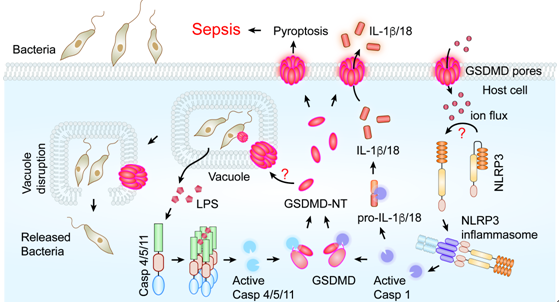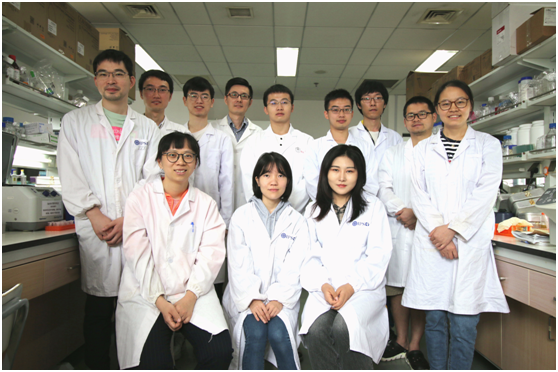
| Name: | Xing LIU | Gender: | |
|---|---|---|---|
| Education: | |||
| Academic degree: | Ph.D. | Academic title: | Principal Investigator |
| Departments: | Anti-infection Immunity and Immune Diseases | Discipline: | Immune Response and Immunotherapy |
| Phone: | 86-21-54923080 | E-mail: | xingliu@ips.ac.cn |
| Mailing Address: | Life Science Research Building 320 Yueyang Road, Xuhui District, 200031 | ||
| Curriculum vitae: |
|---|
| Research direction: |
|---|
| Research progress: |
|---|
Selected Publications (*First author, #Corresponding author) 01. Deng W, Bai Y, Deng F, Pan Y, Mei S, Zheng Z, Min R, Wu Z, Li W, Miao R, Zhang Z, Kupper T, Lieberman J and Liu X#. Streptococcal pyrogenic exotoxin B cleaves GSDMA and triggers pyroptosis. Nature. 2022; doi: 10.1038/s41586-021-04384-4. 02. Zheng Z, Deng W, Bai Y, Miao R, Mei S, Zhang Z, Pan Y, Wang Y, Min R, Deng F, Wu Z, Li W, Chen P, Ma T, Lou X, Lieberman J# and Liu X#. The lysosomal Rag-Ragulator complex licenses RIPK1- and Caspase-8-mediated pyroptosis by Yersinia. Science. 2021; 372, eabg0269. 03. Liu X#, Xia S, Zhang Z, Wu H#, Lieberman J#. Channeling inflammation: gasdermins in physiology and disease. Nat Rev Drug Discov. 2021; 20:384-405. 04. Hu J*, Liu X*#, Xia S, Zhang Z, Zhang Y, Zhao J, Ruan J, Luo X, Lou X, Bai Y, Wang J, Hollingsworth L, Magupalli V, Zhao L, Luo H, Kim J, Lieberman J# and Wu H#. Disulfiram inhibits pyroptosis by blocking gasdermin D pore formation. Nat Immunol. 2020; (7):736-745. 05. Liu X#, Lieberman J#. Knocking 'em Dead: Pore-Forming Proteins in Immune Defense. Annu Rev Immunol. 2020; 38:455-485. 06. Zhang Z, Zhang Y, Xia S, Kong Q, Li S, Liu X, Junqueira C, Meza-Sosa K, Mok T, Ansara J, Sengupta S, Yao Y, Wu H, Lieberman J. Gasdermin E suppresses tumor growth by activating anti-tumor immunity. Nature. 2020; 579(7799):415-420. 07. Cui S, Yu Q, Chu L, Cui Y, Ding M, Wang Q, Wang H, Chen Y, Liu X#, Wang C#. Nuclear cGAS Functions Non-canonically to Enhance Antiviral Immunity via Recruiting Methyltransferase Prmt5. Cell Rep. 2020; 33(10):108490. 08. Liu X, Fu R, Pan Y, Meza-Sosa K, Zhang Z and Lieberman J*. PNPT1 Release from Mitochondria during Apoptosis Triggers Decay of Poly(A) RNAs. Cell. 2018; 174(1):187-201.e12. 09. Ruan J, Xia S, Liu X, Lieberman J, and Wu H. Cryo-EM structure of the Gasdermin A3 membrane pore. Nature. 2018; 557(7703):62-67. 10. Li S, Hong Z, Wang Z, Li F, Mei J, Huang L, Lou X, Zhao S, Song L, Chen W, Wang Q, Liu H, Cai Y, Yu H, Xu H, Zeng G, Wang Q, Zhu J, Liu X#, Tan N#, and Wang C#. The Cyclopeptide Astin C Specifically Inhibits the Innate Immune CDN Sensor STING. Cell Rep. 2018; 25(12):3405-3421.e7. 11. Liu X and Lieberman J. How ICE lights the pyroptosis fire. Cell Death Differ. 2017; 24(2):197-199. 12. Pan Y, Tian T, Park C, Lofftus S, Mei S, Liu X, Luo C, O’Malley J, Gehad A, Teague J, Divito S, Fuhlbrigge R, Puigserver P, Krueger J, Hotamisligil G, Clark R, Kupper T. Survival of tissue-resident memory T cells requires exogenous lipid uptake and metabolism. Nature. 2017; 543(7644):252-256. 13. Liu X, Zhang Z, Ruan J, Pan Y, Magupalli V, Wu H, and Lieberman J. Inflammasome-activated Gasdermin D causes pyroptosis by forming membrane pores. Nature. 2016; 535(7610):153-8. 14. Wittrup A, Ai A, Liu X, Hamar P, Trifonova R, Charisse K, Manoharan M, Kirchhausen T, and Lieberman J. Visualizing lipid-formulated siRNA release from endosomes and target gene knockdown. Nat Biotechnol. 2015; 33(8):870-6. 15. Wang Q*, Liu X*#, Cui Y, Tang Y, Chen W, Li S, Yu H, Pan Y, and Wang C#. The E3 ubiquitin ligase AMFR and INSIG1 bridge the activation of TBK1 kinase by modifying the adaptor STING. Immunity. 2014; 41(6):919-33. Cover Article. |
| Laboratory members: |
|---|

